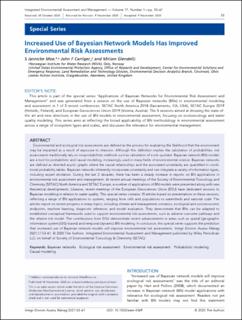| dc.description.abstract | Environmental and ecological risk assessments are defined as the process for evaluating the likelihood that the environment may be impacted as a result of exposure to stressors. Although this definition implies the calculation of probabilities, risk assessments traditionally rely on nonprobabilistic methods such as calculation of a risk quotient. Bayesian network (BN) models are a tool for probabilistic and causal modeling, increasingly used in many fields of environmental science. Bayesian networks are defined as directed acyclic graphs where the causal relationships and the associated uncertainty are quantified in conditional probability tables. Bayesian networks inherently incorporate uncertainty and can integrate a variety of information types, including expert elicitation. During the last 2 decades, there has been a steady increase in reports on BN applications in environmental risk assessment and management. At recent annual meetings of the Society of Environmental Toxicology and Chemistry (SETAC) North America and SETAC Europe, a number of applications of BN models were presented along with new theoretical developments. Likewise, recent meetings of the European Geosciences Union (EGU) have dedicated sessions to Bayesian modeling in relation to water quality. This special series contains 10 articles based on presentations in these sessions, reflecting a range of BN applications to systems, ranging from cells and populations to watersheds and national scale. The articles report on recent progress in many topics, including climate and management scenarios, ecological and socioeconomic endpoints, machine learning, diagnostic inference, and model evaluation. They demonstrate that BNs can be adapted to established conceptual frameworks used to support environmental risk assessments, such as adverse outcome pathways and the relative risk model. The contributions from EGU demonstrate recent advancements in areas such as spatial (geographic information system [GIS]–based) and temporal (dynamic) BN modeling. In conclusion, this special series supports the prediction that increased use of Bayesian network models will improve environmental risk assessments. | en_US |

